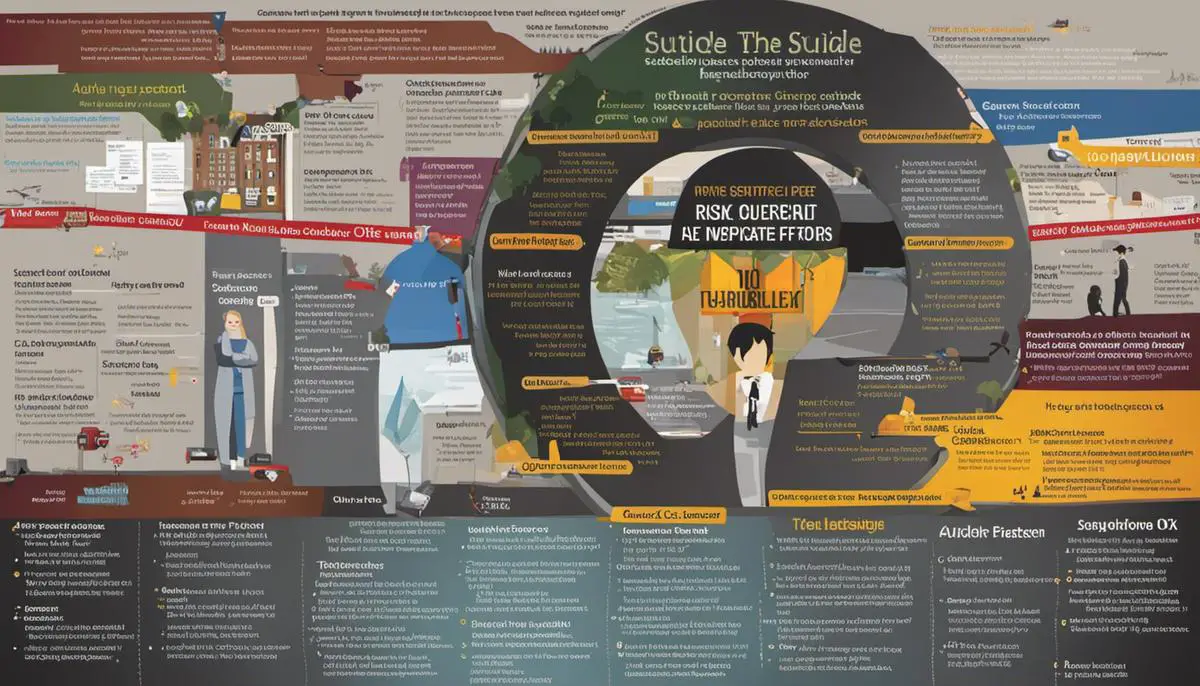Adolescent Suicide Prevention: A Lifesaving Guide

The topic of adolescent suicide is a pressing issue that has profound impact on our global and national communities. This grave reality, often shrouded in silence or overlooked due to social taboos, constitutes a major public health concern, with devastating repercussions for young individuals, their families, and society at large. The statistics are alarming, driving home the urgent need for dedicated action and measures aimed at prevention. Understanding the root causes of adolescent suicide, such as exclusive social pressures, personal battles, and complex mental health struggles, is our key to unlock comprehensive solutions. The ability to discern early warning signs can play a critical role in prevention, and equipping ourselves with this knowledge can quite literally save lives.
The Gravity of Adolescent Suicide
Understanding Adolescent Suicide: A Global Perspective
Adolescent suicide is a growing public health concern that needs immediate attention. According to the World Health Organization (WHO), suicide ranks as the second leading cause of death among 15-29-year-olds globally. In 2019, an estimated 700,000 people died due to suicide worldwide, translating into one suicide every 40 seconds. Although these statistics include people of all ages, a significant portion is attributed to adolescents. The WHO further highlights that for every suicide, there are many more attempts which often go unreported due to the stigmatized nature of self-harming behaviors.
Adolescent Suicide in the United States
Turning focus to the United States, the American Academy of Pediatrics reports that suicide rates among teens have significantly risen in the last decade. The Centers for Disease Control and Prevention (CDC) has noted an alarming increase in the suicide rate among persons aged 10-24 in the U.S., with suicide becoming the second leading cause of death in this age group. Between 2007 to 2018, the suicide rate among this population rose by 57.4%. In 2019 alone, 12% of high school students reported having seriously contemplated suicide, indicating the severity of the problem on the national level.
Current Trends in Adolescent Suicide
Notably, there are recognizable trends in adolescent suicides. Firstly, the suicide rate is found to be higher among males than females, but females are more likely to attempt suicide. Secondly, there is a sharp rise in suicide rates among young people in the lesbian, gay, bisexual, and transgender (LGBT) community. This group faces unique challenges such as discrimination, harassment, and family nonacceptance, which significantly increase suicide risk. Thirdly, there is a clear link between mental health disorders, especially depression and anxiety, and adolescent suicide, pointing to the importance of early mental health intervention.
Importance of Adolescent Suicide Prevention
Given the high prevalence of adolescent suicide, it’s critical to discuss prevention strategies. Open discussions about mental health, including suicide, help break the silence and stigma associated with it, which may encourage affected individuals to seek help. School-based interventions targeting high-risk populations have shown promising results. It’s also vital to provide vulnerable adolescents with appropriate mental health services, and ensure the availability of hotlines for crisis intervention. Integrating suicide prevention in public health policies can help to systematically address the crisis on a broader level.
The Role of Community and Digital Space
Communities and families play crucial roles in recognizing mental health issues and aiding in suicide prevention. Similarly, digital platforms are becoming increasingly important. Recognizing the impact of social media on adolescents, some services are creating programs which aim to identify and support individuals exhibiting suicidal behavior online. The American Psychological Association has identified cyberbullying as a risk factor for suicide among adolescents, stressing the need for establishing safe and supportive digital environments.
Understanding and Preempting a Grave Yet Preventable Situation
In facing the sobering statistics regarding adolescent suicide, it’s crucial to grasp that every instance of suicide remains a preventable tragedy. By adopting thorough prevention strategies, the horrifying impact of adolescent suicide can be greatly reduced. These strategies should emphasize family and community engagement, ready access to suitable mental health services, ensuring digital environments that foster positivity and safety, along with comprehensive education regarding mental health.

Photo by eliottreyna on Unsplash
Understanding the Causes
Shedding Light on the Common Triggers and Risk Elements of Adolescent Suicide
Adolescent suicide often emerges from a complex nexus of multiple factors, including mental health problems, societal demands, and personal hardships. Mental illnesses, like depression, anxiety, bipolar disorder, and substance abuse disorders are frequently linked to suicide among adolescents. Young people struggling with these diseases often perceive suicide as their sole escape from relentless emotional torment.
The adolescent years are characterized by profound emotional and physical changes. The pressure to navigate such transformations, coupled with external societal demands, can push adolescents towards the cliff-edge of suicidal ideation. Society’s pressures manifest in myriad forms, ranging from academic stress and peer pressure to the fear of failure and the ever-looming risk of cyberbullying.
The Role of Personal Struggles in Adolescent Suicide
Personal struggles are an essential aspect of adolescent suicide risk. This can include experiences of abuse, trauma, or significant life changes, such as moving to a new location or the divorce of parents. Personal loss, in particular, often serves as a triggering event for suicidal thoughts. Adolescents who have lost a loved one, or have experienced a romantic breakup, may feel intense feelings of sadness and loneliness, which can increase suicide risk.
The Connection Between Family Dynamics and Adolescent Suicide
Family dynamics also play a significant role in increasing or decreasing suicide risk in adolescents. Adolescents who feel a lack of parental involvement in their lives or experience discord at home are more likely to harbor suicidal thoughts. Conversely, family structures that provide understanding, love, and emotional support can help in mitigating such risks.
The Significance of Access to Lethal Means
In the context of adolescent suicide, having access to lethal means—such as firearms, knives, and certain prescription or illicit drugs—can greatly enhance the risk. Easy access to these methods of self-harm can turn suicidal thoughts into actions.
Co-occurring Risks: The Lethal Interaction of Mental Illness and Substance Abuse
The interaction of mental illness and substance use forms an especially lethal combination. Adolescents who struggle with both mental illness and substance abuse face a significantly higher risk of suicide. Their impaired judgment from substance use can facilitate a decrease in inhibitions, allowing suicidal thoughts to more readily manifest into action.
Key risk factors can serve as vital warning signs, assisting in the prevention of adolescent suicide. The range of potential intervention methods is broad, from hiring mental health professionals in schools to restrict access to lethal means. Important resources such as family support, counseling services, and substance abuse programs also contribute significantly to suicide prevention in adolescents. Further, societal response and community-centered interventions, coupled with mental health awareness programs can make substantial strides in minimizing these risks while enhancing adolescent mental health.

Identifying Warning Signs
Getting to Know the Warning Signs of Adolescent Suicide
Adolescent suicide is an alarming issue in our current society. The Centers for Disease Control and Prevention (CDC) lists suicide as the second leading cause of death for individuals aged 10-34. Early recognition of suicide signs in adolescents is a critical step in prevention, leading to timely intervention, and directing the affected individuals to the required support resources.
A noticeable behavior change in adolescents often serves as one of the most prevalent suicide warning signs. This may include developing an uncharacteristic distance from friends and family, losing interest in activities they used to enjoy, showing disruptive behavior or defiance at school or home. Along with these, the inability to maintain focus or think clearly is a significant sign.
Overt verbal indications may be expressed by adolescents at suicide risk. They might make statements hinting at their absence in the future or explicitly talk about committing suicide. Stating sentiments of self-loathing, hopelessness, and other negative emotions can also serve as warning signs. These may become apparent in daily conversations or may be found in online posts or text messages in the digital age we live in.
An important warning sign to watch out for is a change in sleep and eating patterns. Adolescents contemplating suicide could experience insomnia or, in some cases, sleep more than usual. Changes in appetite, such as eating less or more than the usual, and subsequent noticeable weight loss or gain are other telltale signs.
Physical Symptoms and Other Warning Signs
Physical symptoms can also be an indicator of potential suicide risk in adolescents. Unexplained physical problems like headaches and stomachaches, coupled with a drastic decline in personal appearance or hygiene, can be red flags, particularly when these manifestations exist in conjunction with other warning signs.
The presence of extreme mood swings also serves as a major sign. Adolescents contemplating suicide often demonstrate bouts of severe anxiety, uncontrolled anger, and unusual recklessness. They might express feelings of worthlessness or guilt, appearing exceptionally sad, restless, or irritable.
Adolescents showing warning signs of suicide may also make preparations for their absence. These actions might involve creating a will or giving away their possessions.
Contextual Warning Signs
Several contextual factors may increase the likelihood of an adolescence contemplating suicide. These include exposure to a friend’s or family member’s suicide, having access to lethal means such as firearms or pills, experiencing a recent traumatic event, or living in an environment of constant rejection or abuse.
Significant academic stress or incidents of bullying, either in-person or online, may also be triggers for suicide contemplation. Adolescents with a history of mental illness, especially depression, bipolar disorder, or anxiety disorders, and those with a history of substance abuse have an increased susceptibility.
It is crucial to understand that adolescent suicide is preventable, and the priority lies in recognizing the signs early on. If any indication of distress or mental health issue is observed in a teenager, the best course of action is to seek professional assistance right away. Please refrain from using this information as a means for self-diagnosis. In case there’s any suspicion of a teenager contemplating suicide, don’t hesitate to contact mental health experts immediately or call a suicide prevention hotline, such as the National Suicide Prevention Lifeline, which could be reached at 1-800-273-TALK (1-800-273-8255).

Photo by providence on Unsplash
Prevention Strategies and Resources
How to Prevent Adolescent Suicide
There’s a variety of measures available for preventing suicide among adolescents that chiefly include promptly identifying potential risk factors and intervening adequately. These initiatives are generally classified as universal, which benefit all adolescents, or targeted, designed specifically for teenagers identified as ‘at-risk.’ Universal measures may comprise of school-level prevention programs that enhance mental health literacy, eliminate the stigma linked to seeking help, and provide mechanisms to identify and offer support to students grappling with mental health issues.
School-Based Prevention Programs
School-based adolescent suicide prevention programs can range from standalone initiatives to comprehensive programs that integrate mental health awareness, coping mechanisms, and preventive strategies into the curriculum. There are key components that have proven effective in these initiatives. They involve screening to identify high-risk students, building a crisis response team, and training staff to identify and respond to suicide risk signs. Also, including a peer support scheme can be beneficial as peers might notice changes that adults miss and are more likely to seek help from each other.
Early Intervention and Mental Health Services
Early intervention is one of the cornerstones for tackling adolescent suicide. This involves identifying at-risk individuals, usually those exhibiting signs of depression, anxiety, and other related issues, and directing them toward appropriate mental health services. These services might include individual therapy, family therapy, cognitive-behavioral therapy, dialectical behavior therapy, or case management services where the mental health needs of the adolescent are assessed and addressed holistically. Mental health services also include medication management when necessary, under the supervision of a psychiatric professional.
The Role of Open Communication
Having open lines of communication with teenagers is a vital factor in preventing adolescent suicide. This allows for the early detection of suicidal ideation and various risk factors associated with it. Communication plays a significant role in reassuring adolescents that it’s safe for them to talk about their feelings without fear of judgment or punishment.
Fostering Supportive Environments
Fostering a supportive environment, both at home and school, is key to making adolescents feel safe and accepted. A supportive environment encourages healthy habits, builds resilience and coping skills, and provides multiple avenues for adolescents to express feelings and thoughts. Schools can foster this atmosphere by implementing zero-tolerance bullying policies, promoting inclusivity, and ensuring access to support services. At home, promoting healthy family relationships, providing unconditional support and love, and demonstrating understanding can have a significant impact on an adolescent’s mental wellbeing.
Prevention Resources for Adolescent Suicide
A variety of resources are available to help prevent adolescent suicide, including crisis hotlines such as the National Suicide Prevention Lifeline. There are also numerous websites providing evidence-based data on the topic, alongside community initiative programs that offer mental health education and resources. Additionally, with the rise of technology, mental health support apps have emerged, offering meditation, coping mechanisms, and professional assistance, proving themselves as invaluable tools in adolescent suicide prevention.

Bringing Change Through Education and Advocacy
Emphasizing Education and Awareness for Suicide Prevention
Preventing adolescent suicide is a complex task that requires a combination of strategies. One of the most crucial elements is education. It’s vital to inform parents, teachers, and students about depression’s signs, symptoms, and other potential suicide contributors.
Schools can play a paramount role in early detection of at-risk adolescents. Consequently, teachers, counselors, and school administrators should have the proper training to spot and address suicidal behaviors effectively and promptly. The American Foundation for Suicide Prevention (AFSP) offers a range of educational programs tailored for schools, focusing on how to identify risk factors and make effective preventative measures.
The Role of Advocacy Efforts in Suicide Prevention
Advocacy plays an equally pivotal role in suicide prevention. Advocacy groups carry out the important work of raising awareness about adolescent suicide, breaking down the stigma around mental health struggles, and pushing for new policies and legislation aimed at improving public and mental health. Organizations like the AFSP and the National Alliance on Mental Illness (NAMI) work tirelessly to support at-risk individuals, facilitate relevant research, and lobby for helpful policies at all governmental levels.
Policy and Societal Changes: A Holistic Approach to Prevention
While education and advocacy are indispensable, broader societal and policy changes are necessary for a holistic approach to address adolescent suicide. Policymakers should be encouraged to enact legislation that improves access to mental health services, funds research into suicide prevention, and provides support for suicide survivors, among other things.
A few key policy changes could include mandatory suicide prevention education in schools, more comprehensive mental health coverage under healthcare policies, and stricter regulations around access to lethal means of suicide. Furthermore, fostering a society that promotes open dialogue about mental health and reduces the associated stigmas is crucial.
Inclusive policies that discourage discrimination based on race, sexuality, or gender identity can also significantly reduce rates of suicide attempts among marginalized adolescents.
The Integration of Technology in Suicide Prevention
With numerous adolescents relying on technology for information, it makes sense to leverage digital tools in suicide prevention efforts. Smartphone applications, online screening tools, and teletherapy programs can supplement traditional prevention strategies. These technological tools may offer access to therapeutic resources or hotlines, provide a platform to discuss mental health, or send alerts to guardians or health professionals when the user shows signs of suicidal intent.
Meanwhile, social media platforms have started to recognize their role in mitigating suicide risk among users. Some platforms have initiated policies mandating the reporting of suicide announcements or threats for immediate intervention.
Inclusive policies that discourage discrimination based on race, sexuality, or gender identity can also significantly reduce rates of suicide attempts among marginalized adolescents.
The Integration of Technology in Suicide Prevention
With numerous adolescents relying on technology for information, it makes sense to leverage digital tools in suicide prevention efforts. Smartphone applications, online screening tools, and teletherapy programs can supplement traditional prevention strategies. These technological tools may offer access to therapeutic resources or hotlines, provide a platform to discuss mental health, or send alerts to guardians or health professionals when the user shows signs of suicidal intent.
Meanwhile, social media platforms have started to recognize their role in mitigating suicide risk among users. Some platforms have initiated policies mandating the reporting of suicide announcements or threats for immediate intervention.
Across all sectors, concerted efforts are essential in identifying and supporting adolescents grappling with suicidal thoughts. With rich education, robust advocacy, comprehensive policy reforms, and the strategic use of technology, society can formulate an effective response to prevent adolescent suicide.

As we navigate the intricate landscape of adolescent suicide prevention, the indispensable role of ongoing education and committed advocacy comes to the fore. Simplifying mental health discussions, fostering environments conducive to open communication, and implementing school-based intervention programs can collectively contribute in significant ways towards combating this tragic issue. Additionally, through mobilizing resources and prioritizing strategic interventions, we can extend life-saving support to those in dire need. Encouragingly, it is within our collective reach to reverse the current trends and establish a safer world for our youngsters. The challenge might be arduous, but it is not insurmountable, and every effort made towards prevention can be a beacon of hope in someone’s life.



